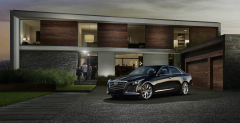DETROIT – After a couple of days test driving the 2014 Cadillac CTS we looked at the price sheet for the car and said whoa. Not because the midsize luxury sedan was overpriced, but at $65,425 as tested, the price point was squarely in line with the midsize sedans offered by German luxury brands. Thus, the bottom line boiled down to could it compete?
To make that determination we started at the back of the car and worked to the front. The trunk was cavernous at 13.7 cu. ft. It was long, deep and looked like an adult could climb in and be quite comfortable. It could handle a couple of bodies or at least three perhaps four sets of golf clubs.
Still, the place for bodies, live ones, was in the back seat. And this is where the CTS excelled. The space in the midsize car’s rear seat rivaled a full-size sedan. There was plenty of headroom, legroom and because of the width of doors getting in and out didn’t require contortions.
Backseat passengers had their own automatic climate control system as well as heated seats. Those seatbacks would fold creating a pass-through, thus, making more cargo space. Yes, Cadillac says the car can handle five passengers but like most rear-wheel-drive sedans, four people are its comfortable capacity.
Privacy could be maintained by utilizing the manual shades for the side windows, of course there was a driver operated power shade on the rear window and ample light could be had through the panoramic roof. The front part was movable and the rear half of the glass pane over the rear seats was fixed.
The Cadillac CTS, like its siblings, distinguished itself in the front seats. Heated and cooled, they featured lumbar supports and manually operated lower leg supports. What’s more the center stack was button free.
First was the interior itself. It was perforated leather in a gray and red motif with French stitching throughout. And there was carbon fiber trim. There was also a bit of alcantara, a suede-like material used in upper trim line luxury vehicles, layered into the doors and onto the dash. That Cadillac used it in the CTS was evidence that the brand is reaching for the buyers of European luxury cars.
The CTS featured Cadillac’s CUE system (Cadillac User Experience). Everything – audio controls, climate controls, media controls, navigation controls, vehicle controls, and etcetera – could be managed from this surface that combined a touch screen, touch template and metallic icons. It was different and it was where the revamped Cadillac really distinguished itself from its competitors.
The car had a TFT screen that projected images of its instruments. It was customizable to display information that could be chosen from several menus. It was also confusing. There was too much information to read or to quick-glance while moving.
What made this hodge-podge of information palatable was the adjustable heads up display. It could show miles-per-hour plus the odometer, or mph plus the speed limit, or mph plus the direction the car was headed or mph plus the media that was being played. It was simple and it was just what you needed to know in real time.
Under the hood was a 2.0-liter four-cylinder direct injection turbocharged engine that made 272 horsepower and 295 pounds-feet of torque. Of the CTS’ three engine choices, this one had the least amount of oomph.
Still, it was a capable power plant. Mated to a six-speed automatic transmission with paddle shifters, the CTS could move smartly. The engine was responsive, there wasn’t any overt turbo lag and being small, fuel economy wasn’t bad: 19 mpg in the city and 30 mpg on the highway.
Later, we test drove the CTS Vsport. The car was at the top of the CTS food chain in terms of power. It had a 3.6-liter dual turbocharged V6 that made 420 horsepower and 430 pound-feet of torque at 2,500 rpm. Mated to an eight-speed automatic transmission, with this car’s torque was hard to keep at a cruising speed.
It was like driving a bullet that could make right angle turns. The CTS Vsport was light, maneuverable, had several ride modes including Touring, Sport and Track. At its core was Cadillac’s standard 3.6-liter V6 but it had been reamed and re-bored.
It had an all new cylinder block and head castings, stronger connecting rods, domed aluminum pistons with top steel ring carriers for greater strength, a10.2:1 compression ratio, integrated charge air cooler system with low-volume air ducts, two turbochargers that produced more than 12 pounds of boost (80 kPa), vacuum-actuated wastegates with electronic control valves, all-new direct injection fuel system, and tuned air inlet and outlet resonators and aluminum cam covers.
It’s laughable to think of the Vsport as having the same engine with a couple of turbochargers. Our Vsport had more power but cost less than the CTS with the 2.0 liter engine, $60,830. But it didn’t have a panoramic roof, alcantara and carbon fiber interior trim, no lower leg supports in the front seats and no rear shade screens on the side windows.
The CTS is longer, lower and lighter than the model it replaced. It had a 50-50 weight distribution and real time damping controls that Cadillac called Magnetic Ride Control. There were three ride settings on the 2.0-liter equipped car: touring, sport and snow. The suspension smoothed ruddy surface streets, handling was smart but the steering ratio could have been a tad quicker.
Cadillac’s shield grille was wider on the 2014 CTS. What has become the brand’s signature, its vertical LED daytime running lights were brighter and the headlamps flowed up into the hood line. At a glance the car looked like the old CTS but in that same glance you know it’s the new one. It is the same for the 2015 model.
The car had all of the bells and whistles you’d expect in this price range: back up camera, full stop adaptive cruise control and adaptive headlights, driver awareness package, 19-inch polished aluminum wheels, satellite radio, voice controls and of course OnStar with its myriad of attributes including locking or unlocking the doors in case you misplace your keys.
In a word, yes, the Cadillac CTS can compete with Germany’s finest in terms of performance, equipment, comfort, driving characteristics, style and ambiance. And for 2015, Cadillac continues to improve: Amongst its enhancements, the 2015 CTS now has available wireless phone charging, text message alerts, integrated, OnStar with 4G LTE and standard built-in Wi-Fi hotspot and a perpendicular parking feature added to available automatic parking assist.
With the world’s best luxury brands, it is all about style and technology encased in comfort. Cadillac is making a serious effort to join that group.
Frank S. Washington is editor of AboutThatCar.com.





